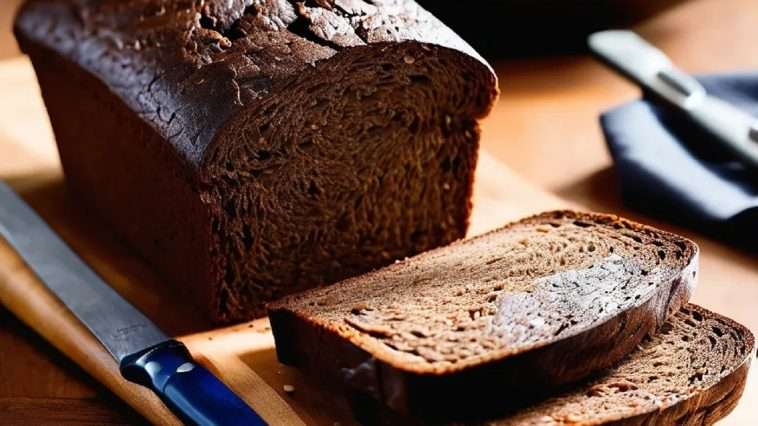Pumpernickel bread is a dark, dense bread traditionally made from coarsely ground rye flour. Its origins trace back to Germany, where it was commonly enjoyed as a staple food, particularly in the regions of Westphalia. The name “pumpernickel” is thought to derive from the German words “pumpern” (to break wind) and “Nickel” (a colloquial term for the devil), humorously referring to the bread’s hearty nature and dense texture. With its rich flavor and distinctive dark color, pumpernickel has become a beloved bread around the world.
Why I Love Pumpernickel Bread Recipe
I love this pumpernickel bread recipe for its deep, robust flavor and unique texture. Unlike lighter breads, pumpernickel offers a satisfying chewiness that pairs perfectly with a variety of toppings, from creamy spreads to hearty meats. The subtle sweetness from the molasses adds an extra layer of complexity, making each bite a delightful experience.
Moreover, baking pumpernickel bread fills my kitchen with an irresistible aroma that brings a sense of warmth and comfort. It reminds me of family gatherings where homemade bread was always a centerpiece, inviting everyone to sit down and share a meal. This recipe not only connects me to those cherished memories but also allows me to create something delicious from scratch.
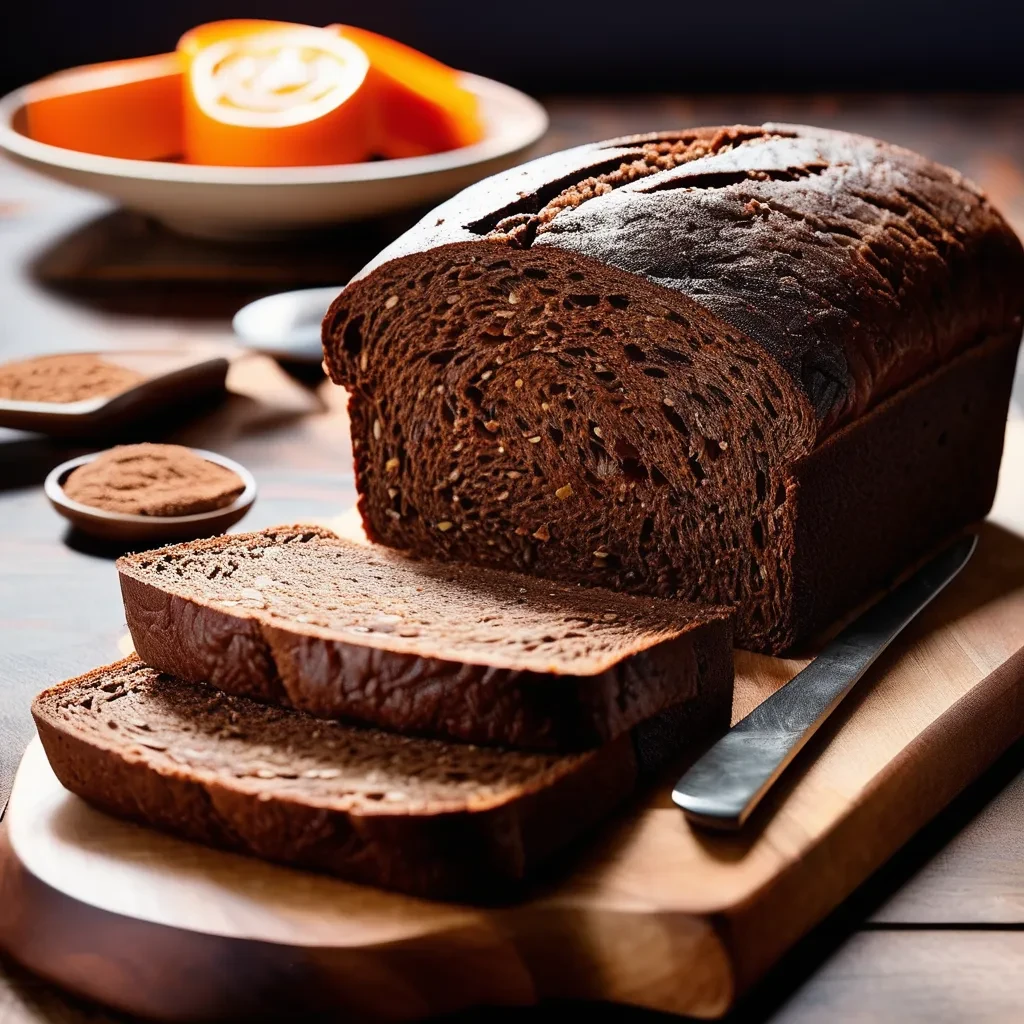
Serving Suggestions For Pumpernickel Bread Recipe
Pumpernickel bread’s rich, earthy flavor and dense texture make it an excellent companion to a variety of dishes. Here are four delicious serving suggestions that showcase its versatility:
- Open-Faced Sandwich: Transform a slice of pumpernickel into a gourmet open-faced sandwich by layering smoked salmon, a generous spread of cream cheese, and a sprinkle of fresh dill. Add thinly sliced cucumbers and a squeeze of lemon juice for a refreshing finish. This combination not only highlights the bread’s unique flavor but also creates a visually stunning dish that’s perfect for brunch or a light lunch.
- Charcuterie Board: Pumpernickel bread is a fantastic addition to a charcuterie board, where its hearty texture can hold up against a variety of cheeses and cured meats. Pair it with sharp cheddar, creamy brie, and slices of prosciutto, along with pickles, olives, and a selection of jams. The bread serves as a robust base for building flavorful bites, making it a hit at gatherings and parties.
- Soup Companion: Serve warm slices of pumpernickel alongside a hearty soup, such as a rich potato leek or a creamy mushroom bisque. The dense bread is perfect for dipping and soaking up the savory broth, enhancing each spoonful of soup. This comforting combination is ideal for chilly evenings and makes for a satisfying, wholesome meal.
- Sweet Toast: For a unique breakfast or snack, toast slices of pumpernickel and spread them with butter and your favorite fruit preserves, such as raspberry or apricot jam. The contrast of the sweet jam against the earthy flavor of the bread creates a delightful balance. Top with a sprinkle of cinnamon or a dollop of Greek yogurt for added creaminess and flavor.
These serving suggestions highlight the unique qualities of pumpernickel bread, making it a delightful addition to any meal or occasion!
Variations For Pumpernickel Bread Recipe
Pumpernickel bread is incredibly adaptable, allowing for a variety of creative twists. Here are four variations to inspire your baking:
- Seeded: Enhance your pumpernickel bread by incorporating a mix of seeds, such as sunflower, sesame, and flaxseeds, into the dough. This variation not only adds a delightful crunch but also boosts the nutritional profile of the bread, providing extra fiber, healthy fats, and protein. The seeds complement the rich flavor of the rye and create a visually appealing loaf that’s perfect for any table.
- Spiced: Elevate the flavor of your bread by adding spices like caraway seeds, fennel, or dill to the dough. These spices enhance the traditional taste of pumpernickel and provide an aromatic experience with every bite. This spiced variation is particularly delicious when paired with cheeses or used as a base for sandwiches, adding an intriguing depth of flavor.
- Chocolate: For a unique dessert twist, consider making chocolate pumpernickel bread. By incorporating cocoa powder and dark chocolate chunks into the dough, you create a subtly sweet bread that can be enjoyed on its own or with a cup of coffee. This variation is perfect for an afternoon snack or as a decadent breakfast treat, appealing to both chocolate lovers and bread enthusiasts alike.
- Herbed: Infuse your pumpernickel with fresh herbs like thyme, rosemary, or basil for a fragrant and flavorful loaf. These herbs can be added directly to the dough or sprinkled on top before baking for an aromatic touch. This herbed version pairs beautifully with soups, salads, or simply as a side with olive oil for dipping, enhancing the overall dining experience.
These variations allow you to experiment with bread, adding exciting new flavors and textures that keep this traditional loaf fresh and interesting!
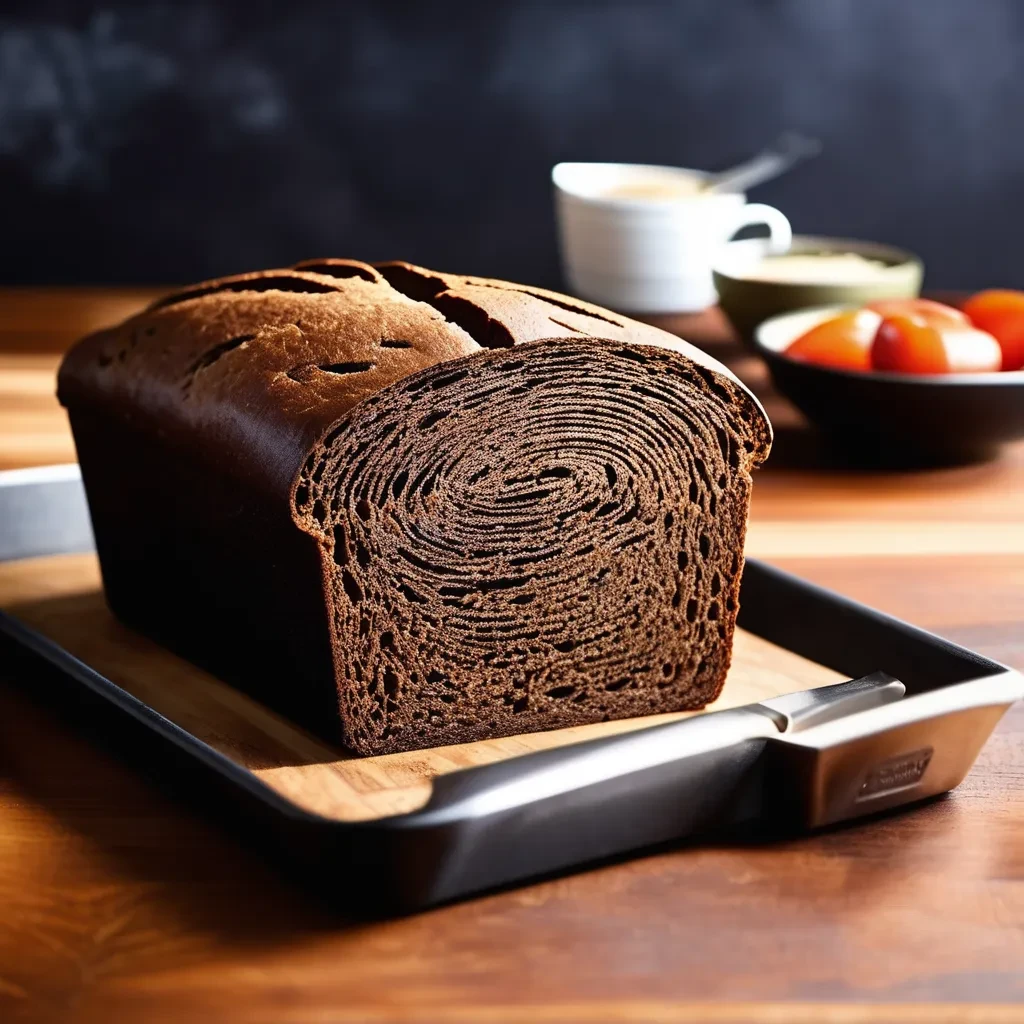
Storage and Shelf Life For Pumpernickel Bread Recipe
Proper storage of pumpernickel bread is essential to maintain its freshness and flavor. Here are some guidelines to help you keep your bread in optimal condition:
- Cool, Dry Place: Store bread in a cool, dry place, preferably wrapped in a clean kitchen towel or placed in a paper bag. This allows for some air circulation while preventing moisture buildup that can lead to mold.
- Refrigeration: If you live in a particularly humid climate or if the bread will not be consumed within a few days, consider refrigerating it. While this can slightly alter the texture, it helps prolong the shelf life by preventing spoilage.
- Freezing: For long-term storage, slice the bread and place it in an airtight container or a resealable plastic bag before freezing. Pumpernickel bread can last for up to three months in the freezer without significant loss of quality. Just make sure to separate the slices with parchment paper to prevent sticking.
- Check for Freshness: Always inspect the bread for signs of mold or staleness before consuming. If the bread has an off smell or unusual texture, it’s best to discard it to ensure food safety.
By following these storage tips, you can keep your pumpernickel bread fresh and flavorful for longer, allowing you to enjoy its rich taste whenever you desire.
Health Benefits Of Pumpernickel Bread Recipe
bread is not only delicious but also packed with several health benefits that make it a nutritious choice for any diet. Here are some key advantages:
- High in Fiber: Made from whole grain rye flour, bread is an excellent source of dietary fiber. This aids in digestion, promotes regular bowel movements, and helps maintain a feeling of fullness, which can be beneficial for weight management.
- Low Glycemic Index: it has a low glycemic index, meaning it causes a slower, steadier rise in blood sugar levels compared to white bread. This makes it a suitable option for those looking to manage their blood sugar, including individuals with diabetes.
- Rich in Nutrients: This hearty bread is packed with essential vitamins and minerals, including B vitamins, iron, magnesium, and antioxidants. These nutrients play vital roles in energy production, immune function, and overall health.
- Heart Health: The whole grains and fiber content in bread may help lower cholesterol levels and support cardiovascular health. Additionally, the rye used in pumpernickel contains compounds that can contribute to a healthy heart.
Incorporating pumpernickel bread into your diet not only enhances your meals but also provides numerous health benefits, making it a smart and delicious choice for anyone looking to improve their nutrition!
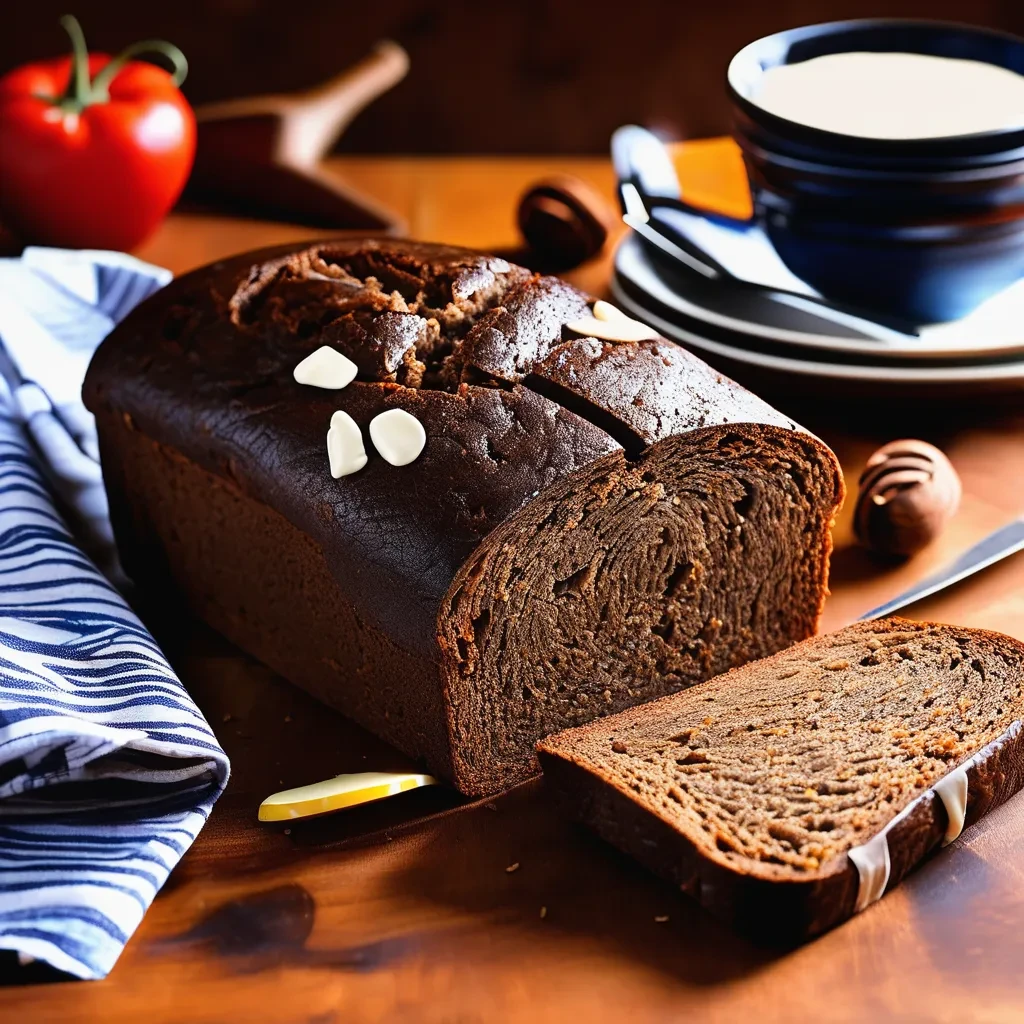
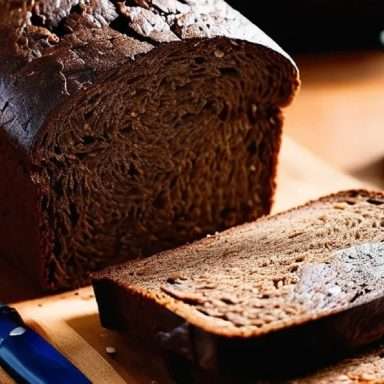
Pumpernickel Bread Recipe
Equipment
- Mixing bowl
- Measuring cups and spoons
- Wooden spoon or dough scraper
- Loaf pan
- Clean kitchen towel
- Oven
Ingredients
- 2 cups coarsely ground rye flour
- 1 cups all-purpose flour
- 1½ cups warm water
- 2 tablespoon molasses
- 1 teaspoon active dry yeast
- 1 teaspoon salt
- 1 tablespoon caraway seeds
Instructions
- Activate the Yeast: In a mixing bowl, combine the warm water and active dry yeast. Let it sit for about 5–10 minutes, or until it becomes frothy.
- Mix Ingredients: Add the molasses, salt, and caraway seeds (if using) to the yeast mixture. Stir to combine. Gradually add the coarsely ground rye flour, followed by the all-purpose flour, mixing until a dough forms.
- Knead the Dough: Turn the dough out onto a lightly floured surface and knead for about 5–7 minutes until it becomes smooth and elastic. You can also use a stand mixer with a dough hook for this step.
- First Rise: Place the kneaded dough in a lightly greased bowl, cover it with a clean kitchen towel, and let it rise in a warm place for about 1 hour or until it has doubled in size.
- Shape the Dough: Once the dough has risen, punch it down to release air. Shape it into a loaf and place it in a greased loaf pan.
- Second Rise: Cover the loaf pan with the kitchen towel and let the dough rise again for about 30–45 minutes, or until it has puffed up.
- Preheat the Oven: While the dough is rising, preheat your oven to 375°F (190°C).
- Bake the Bread: Once the second rise is complete, place the loaf in the preheated oven and bake for 30–40 minutes, or until the bread sounds hollow when tapped and has a dark crust.
- Cool the Bread: Remove the bread from the oven and let it cool in the pan for about 10 minutes. Then, transfer it to a wire rack to cool completely before slicing.
Related Video
Related Notes
- Quality Ingredients: Use high-quality rye flour for the best flavor and texture. Fresh ingredients can significantly enhance the taste of your bread.
- Temperature Control: Ensure your water is at the right temperature (about 110°F/43°C) when activating the yeast. Too hot can kill the yeast, while too cold may not activate it effectively.
- Kneading Technique: Knead the dough until it is smooth and elastic. This helps develop the gluten, which is essential for a good rise and texture.

